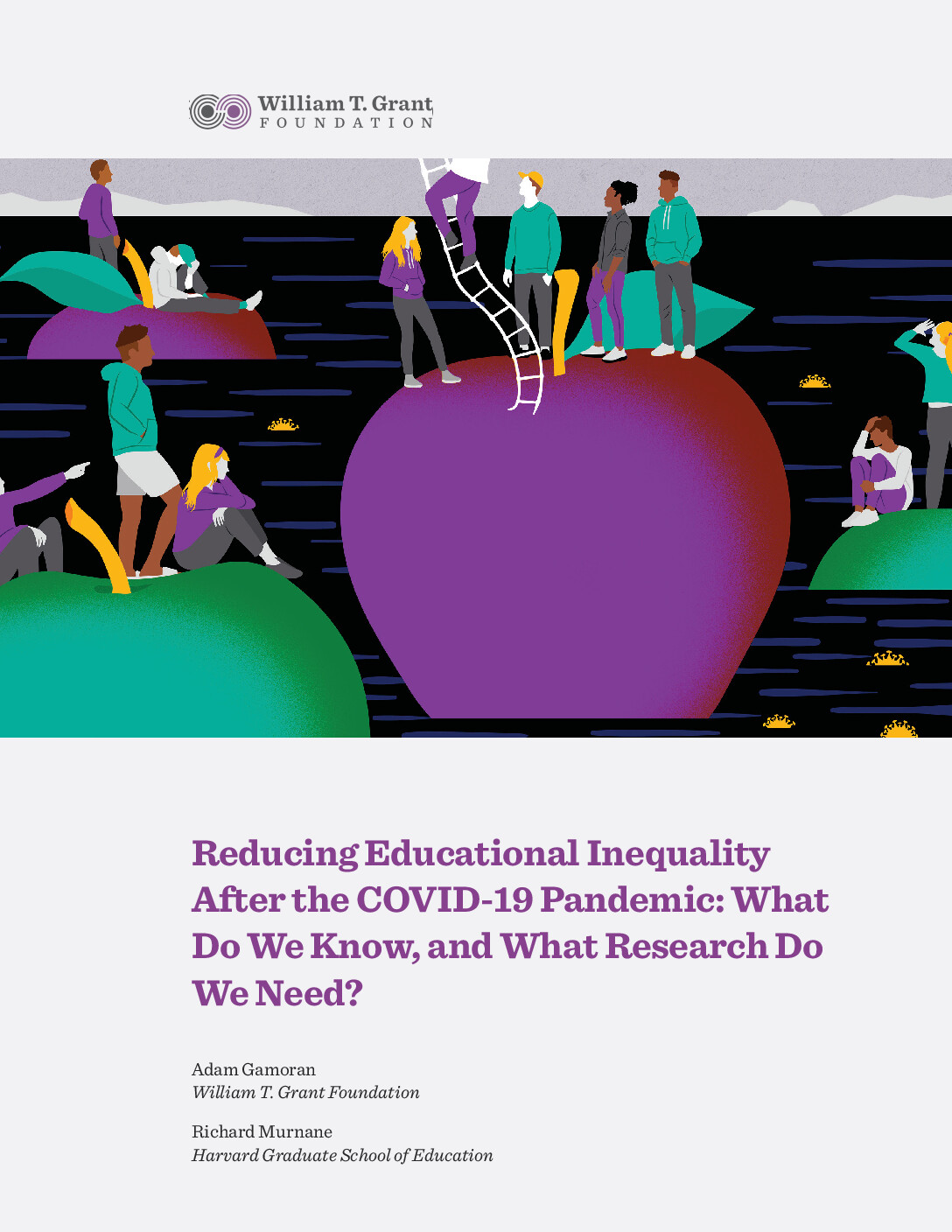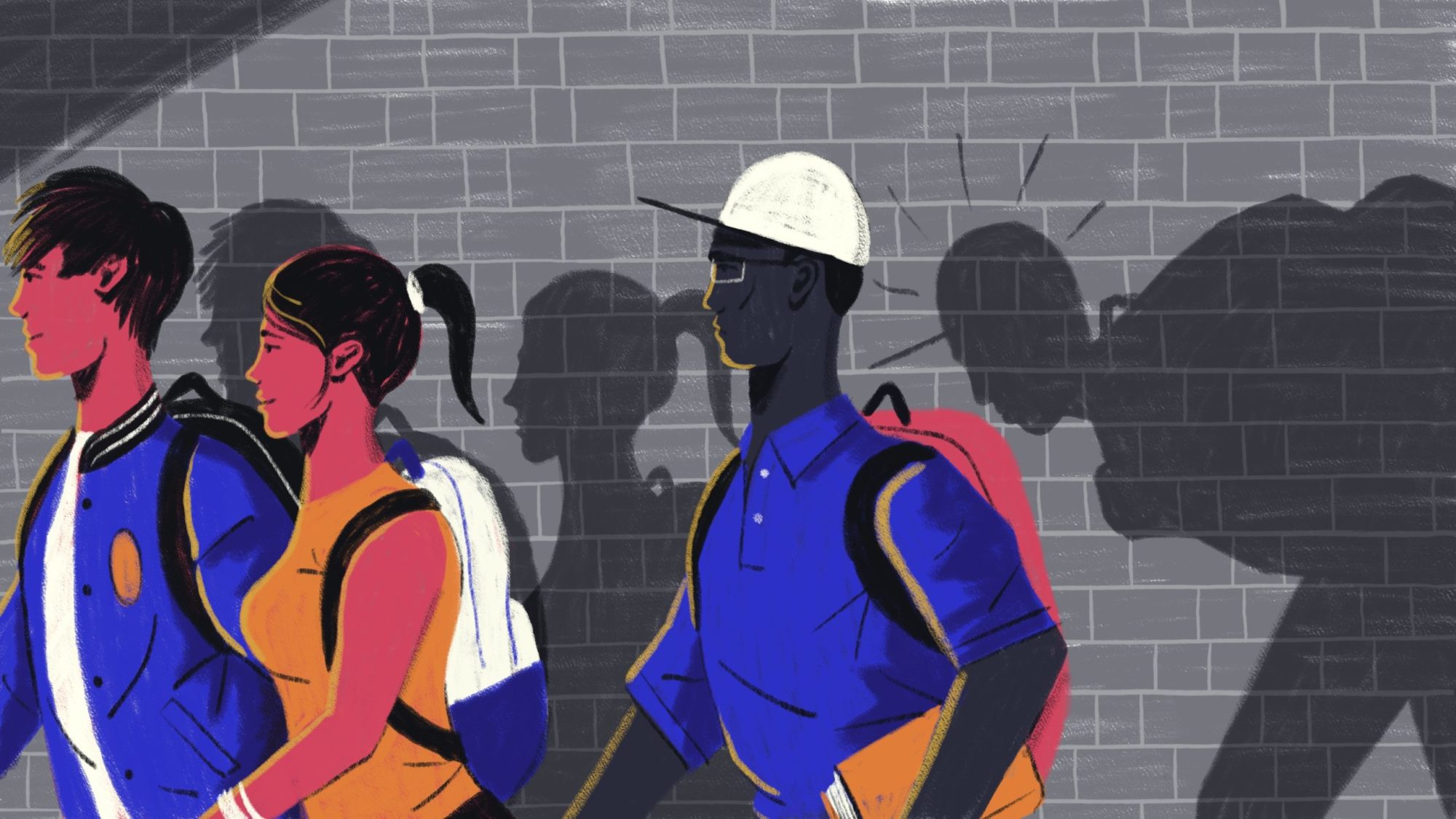When President Barack Obama declared in December 2013 that the stifling combination of growing inequality and lack of upward mobility constituted “the defining challenge of our time,” he pointed to education as a pathway to economic opportunity (Obama, 2013).1 Nevertheless, the President acknowledged, education is a restricted avenue for important segments of our society. Compared to other nations, as well as to our own history, educational inequality in the U.S. remains exceptionally high (Gamoran, 2001, 2014). Indeed, the education system in the United States works well for some, but poorly for many others (Gamoran, 2001). Whereas racial and ethnic differences in test scores have narrowed over the decades, differences by economic circumstances have ceded little ground, or have even grown in recent years (Reardon, 2011, 2021). Likewise, whereas racial and ethnic differences in high school completion and college enrollment rates among Black students and White students have diminished, differences in college completion rates have grown (Bailey & Dynarski, 2011; Papay et al., 2020). At the same time, modest differences in mental health outcomes by race and ethnicity have been swamped by large differences in access to mental health services, thereby disadvantaging those from Black, Indigenous, and immigrant communities (Alegría et al., 2015). Educational inequality is thus a long-standing and persistent challenge. Indeed, when it comes to education in the U.S., inequality is not just the defining challenge of our time, but of all time.
Never has this inequality been more evident than during the COVID-19 era. The pandemic put existing divisions into sharp relief, and made them worse. Recent evidence tells a terrible story of the consequences of the pandemic—and the response of the education system to the pandemic—for educational inequality. Today, as the pandemic recedes, its effects are still with us, in education as well as in other domains.
Fortunately, we have considerable knowledge about how to respond to growing inequality. As we explain below, we have learned through research that effective responses include high-quality tutoring, effective expanded learning time, and strengthened relationships between learners and educators. Yet many questions remain, and new research is needed to help ensure that our education system not only overcomes the increase in inequality induced by the pandemic, but reduces the inequality that was already in place prior to 2020. In this essay, we discuss the consequences of the pandemic for educational inequality, examine research-based strategies for responding to inequality, and identify new areas for research that can take us further down the road to an equitable education system.
Educational inequality and the COVID-19 pandemic
It was not hard to anticipate that achievement growth would be lower during the pandemic than it had been previously. Disruptions large and small, from natural disasters to switching schools, tend to depress achievement (Harris, 2020; Grigg, 2012). The COVID-19 pandemic caused massive disruptions to schooling, with many schools shutting down briefly before reopening in a virtual environment that was more accessible to some than others. In addition, the virus itself caused unprecedented disruptions for many families, particularly for the more than 140,000 children in the U.S. who lost a parent or caregiver to COVID-19 (Hillis et al., 2021). It was widely expected that the pandemic would exacerbate achievement gaps: A survey administered to over 200 education researchers in fall 2020 revealed predictions that achievement differences by socioeconomic status would grow between .25 and .30 standard deviations over the course of the first pandemic-afflicted academic year (Bailey et al., 2021).
These expectations have, unfortunately, been confirmed. By 2021, achievement growth was about .25 standard deviations lower in math, and .15 standard deviations lower in reading, according to data from the Northwest Education Association’s Measures of Academic Progress (MAP), a large data set drawn from millions of students nationwide, though not a nationally representative sample (Kuhfeld, Soland, & Lewis, 2022). Further analyses of these data revealed that growth was hampered much more severely in high-poverty school districts than in low-poverty school districts (Goldhaber et al., 2022a). For example, in high-poverty districts, math achievement in third grade was lower by .44 standard deviations compared to what would likely have occurred based on pre-pandemic achievement trajectories. The comparable figure in low-poverty districts was .16 standard deviations—still an important contraction in learning growth, but not as severe, and thus a major contribution to widening achievement gaps. Shortfalls in growth appeared largest in the younger tested grades (3rd, 4th, and 5th compared to 6th, 7th, and 8th), but the differences by level of school poverty occurred at every grade level.
Racial and ethnic gaps also grew. For example, math achievement for third graders was .20 standard deviations lower than predicted for Asian American students and .22 lower for White students, but it was .38 lower for Hispanic students and .45 lower for Black students than predicted on the basis of pre-pandemic achievement trajectories (Goldhaber et al., 2022a). The COVID-19 experience thus exacerbated achievement inequality well beyond its initial, unequal level. Examining the MAP data further, Goldhaber et al. (2022b) determined that the more time students spent in remote instruction, the greater the contraction in learning rates. High-poverty districts compared to middle- and low-poverty districts, as well as Black and Hispanic students compared to White students, were more exposed to remote instruction, and the authors concluded that “the shift in instructional mode was a primary driver of widening achievement gaps” (Goldhaber et al., 2022b, p. 2). For high-poverty districts and Black and Hispanic students, the gaps widened for two reasons: first, students in these districts spent more time in remote instruction, and second, remote instruction was more harmful for these students than for others, presumably due to inadequate resources to support remote instruction.
A recent analysis of the results of mathematics and reading tests in 29 states supports the evidence from the MAP tests. Fahle et al. (2022) reported that the median school district lost the equivalent of 52 percent of a year’s worth of achievement growth in mathematics and 23 percent of a year’s worth of achievement growth in reading. Importantly, the losses were larger in high-poverty districts. In math, the quarter of districts with the highest share of students receiving federal lunch subsidies lost the equivalent of 66 percent of a year’s worth of achievement growth in math, while low poverty districts lost 45 percent of achievement growth. The differences in reading loss were smaller, but also substantial.
Achievement rates are not the only important outcomes that suffered during the pandemic (Hough et al., 2022). COVID-19 caused unprecedented stress for educators, learners, and families alike. In a survey of parents conducted by the Mott Children’s Hospital (2021), nearly half of parents of teens reported a new or worsening mental health problem for their child. In another survey, youth reported that the primary obstacle to their learning during the pandemic was feeling depressed, stressed, or anxious (YouthTruth, 2021). Noting that adolescents studying in person exhibited, on average, higher levels of well-being than those studying remotely, Duckworth et al. (2021) identified a “thriving gap” as a parallel phenomenon to learning gaps that were exacerbated by the pandemic.
Can educational inequalities be reversed?
On one hand, existing research provides substantial guidance for how school districts could respond to the increases in learning and thriving gaps that resulted from the pandemic. On the other, the research has less to offer about how to overturn the structural conditions that created these inequalities in the first place, and caused them to widen during the pandemic. This gap in our knowledge underlines the need for new research.
The Education Trust (2022), working in partnership with Jean Grossman from MDRC and with support from the William T. Grant Foundation, has provided concrete guidance to states, school districts, and schools on research-backed strategies to reduce the inequality growth created by the pandemic. The strategies center on strengthening relationships between educators, learners, and families, providing tutoring to struggling students, and expanding effective learning time.
Strengthening relationships between educators, learners, and families
The COVID-19 pandemic shattered relationships between families and schools. Despite the enormous efforts of teachers and other school staff, it was impossible to maintain the same degree of interpersonal contact while schools were closed to in-person instruction. As a result, the pandemic undermined trust between families and schools, which in normal times facilitates parent-teacher collaboration toward helping children succeed. Disrupted relationships not only battered children’s learning, but also contributed to the sense of stress and isolation that children, parents, and educators experienced, likely contributing to the heightened mental health challenges that surfaced during the pandemic. Because Black and Hispanic students and students in low-income schools had more of these isolating experiences, the disruption of relationships likely contributed to increased inequality in both academic and social emotional development. Indeed, school district leaders in high-poverty districts reported less capacity to respond to students’ social emotional needs during the pandemic than those in low-poverty districts (Vinson & Naftzger, 2020).
Based on a review of the research literature, and especially a recent synthesis by Roehlkepartain at al. (2017), Education Trust and MDRC identified five key elements of programs to build relationships that help students thrive:
- Expressing care, such as being dependable, listening well, and encouraging students
- Challenging students to grow, such as expecting the best, holding students accountable, stretching them and helping them reflect on failures
- Providing support, such as helping them navigate challenging situations, empowering them, advocating for them, and setting boundaries
- Sharing power, as reflected in respect, inclusion, collaboration, and letting students lead
- Expanding possibilities by inspiring students, broadening their horizons, and connecting them to others who can help.
The authors cited a number of evidence-backed programs that incorporate these elements, including Project Arrive, a San Francisco-based mentoring program for students moving from middle to high school (Chan et al., 2019), Communities in Schools, a national organization that provides wrap-around services in low-performing schools (Parise et al., 2017), and Building Assets Reducing Risks, a whole-school model that aims to meet student needs by building on their strengths (Corsello & Sharma, 2015). According to the Education Trust/MDRC team:
The most important thing schools can do to foster these relationships is to have a culture that explicitly values adults nurturing relationships with students and providing teachers and school staff with the time, space, and occasions to interact repeatedly with individual students, especially those that seem less engaged.
As schools emerge from two years of disruptions, achieving these goals is more important than ever.
Targeted intensive tutoring
If the progress of all students had slowed at the same rate during the pandemic, one might conclude that the pace of academic recovery is less important than ensuring that all students feel safe and secure. Unfortunately, both students in low-income districts and those from minoritized backgrounds were more sharply impeded by the conditions of the pandemic, making academic acceleration essential for these students. Gloria Ladson-Billings’ (2006) term, “education debt,” is appropriate here: As a nation, we owe a debt to students who lost the most during the pandemic to make up for lost ground.
One-on-one or small-group tutoring has long been recognized as an effective means of helping struggling students make up for unfinished learning (e.g., Farkas, 1998). Citing a recent meta-analysis (Nickow, Oreopoulos, & Quan, 2020), the Education Trust and MDRC researchers identified conditions that lead tutoring to have greater impact on learning. While tutoring is most effective for younger learners, they noted, it can also be effective for middle and high school students (Guryan et al., 2021). Now, in light of findings that achievement gaps grew the most among the younger learners during the pandemic, intensive tutoring targeted to student needs may be an especially important pandemic response. The authors also noted that tutoring is more effective when delivered by trained tutors, one-on-one, and using highly structured curricula.
As school districts across the country implement large-scale tutoring efforts, it is important to bear in mind that this is not our first attempt at mass tutoring, and the last attempt ended in failure. Under the No Child Left Behind Act of 2001, schools that did not meet achievement targets were required to provide “supplemental educational services”—mainly tutoring—to struggling students. Subsequent research concluded that this effort was unsuccessful because group sizes were too large, the tutoring was not coordinated with classroom instruction, student attendance at tutoring sessions was poor, and only about 20% of students eligible for tutoring actually received services (Farkas and Durham, 2007). This was one of many reasons that No Child Left Behind failed to achieve its aims (Gamoran, 2007). Tutoring in response to the COVID-19 pandemic will be even more challenging, and its chances of success depend on school districts taking these lessons to heart.
Expanded learning time
The third strategy identified by the Education Trust and MDRC is expanding learning time to allow students who have been hardest hit by the pandemic to make up for the learning opportunities they missed. Expanded learning time is a strategy to accelerate learning by allowing more time to meet learning goals (Redd et al., 2012). Synthesizing available research, the authors concluded that:
- A curriculum that is aligned with school learning is a more effective tool for expanded learning time than one that is not aligned with school learning or that lacks clear learning goals.
- Trained instructors are more effective during expanded learning than untrained instructors.
- Expanded time during the school year is more effective than summer programs.
- Mandatory time during the school day is more effective than mandatory time outside the school day, and both are more effective than voluntary time.
- Expanding learning time by 45-100 hours is more effective than greater or lesser amounts of time.
- Small classes of 10-15 students are more effective than larger classes.
- Additional time with certified teachers is more effective than time with uncertified instructors.
Effective expanded learning efforts included providing students with an extra period of instruction in a particular subject during the school day (Cortes & Goodman, 2014), “acceleration camps” in which students receive full days of additional instruction (Schueler, Goodman, & Deming, 2014), and mandatory summer programs (Matsudaira, 2008). The authors noted that not all expanded learning programs are effective, and they stressed the importance of centering equity and providing high-quality instruction as essential for success. They also recognized the possible trade-off between mandated extra learning time and enrichment activities:
Students of color and students from low-income backgrounds, who, even before the pandemic, had the least access to enrichment programs and quality educational opportunities, should not miss any more of these opportunities . . . . While scheduling may be challenging, it important to ensure students are not made to feel penalized or stigmatized by taking away their breaks, electives, or other periods known to improve engagement among students.
Thus, meeting the goal of equitable provision of expanded learning time will be challenging for school districts.
Research to restructure schooling for equity
The three strategies identified by the Education Trust and MDRC offer promising, research-backed starting points for fulfilling our education debt to students who were hardest hit by the pandemic. Previous research also provides guidance about promising strategies. However, in every case, a close look shows that there remain critical questions that need to be answered through research to implement the promising strategies in a way that maximizes their effectiveness in reducing inequalities.
Skilled teachers
Many research studies show that children taught by experienced, highly skilled teachers learn a great deal more during a school year than those taught by less skilled teachers (Chetty, Friedman, & Rockoff, 2014; Murnane, 1975; Rockoff, 2004). Unfortunately, research also shows that schools serving large percentages of low-income students (i.e., high-poverty schools) are much less likely to have experienced, skilled, and stable teaching staffs than schools serving more economically advantaged students (Goldhaber, Quince, & Theobald, 2018). The pandemic has increased the challenge of providing high-poverty schools with skilled teachers, as many teachers have left the profession due to burnout and the stress of teaching remotely students who lack computers, reliable access to the Internet, and a quiet place to study.
As Johnson, Kraft, and Papay (2012) have documented, a critical requirement for attracting and retaining skilled teachers in high-poverty schools is high-quality working conditions, including sufficient resources to deal with the challenges students face. A recent study documenting that being in a class with a child whose behavior is negatively impacted by consumption of lead-based paint reduces the long-term achievement of classmates illustrates the classroom management challenges that many teachers in high-poverty schools face (Gazze, Persico, & Spirovska, 2022). This is only one example of the type of research needed to understand how poverty affects children and their classmates. Complementary research would increase our understanding of how to support children whose lives have been scarred by poverty.
School finance reform
Recent research has shown convincingly that providing high-poverty schools with more money enables them to improve long-term outcomes for students (Jackson, Johnson, & Persico, 2016; LaFortune, Rothstein, & Schanzenbach, 2018). Moreover, one new study shows that such reforms are not only equitable, but efficient; i.e., increased funding to high-poverty schools boosts achievement more than increased funding to low-poverty schools (Rauscher & Shen, 2022). Reform of school aid formulas in many states, including California, Massachusetts, and Washington, are providing high-poverty schools with additional funds needed to respond effectively to their students’ needs. As described above, recent research has provided considerable guidance about promising uses of such funds. However, there remains much to be learned about how to translate additional funding into programs and school environments that are attractive to skilled teachers and that serve all students well.
Out-of-school opportunities
Research has documented that differences in opportunities outside of time spent in school between children and youth from low-income families and those from more economically advantaged families contribute to differences in academic skills (Phillips, 2011). A recent evaluation of a program in Boston that provided summer jobs and learning opportunities to high-school students from low-income families revealed positive impacts on high school graduation rates (Modestino, 2023). Importantly, Modestino demonstrated recently that mounting a program of effective summer jobs and internship opportunities was possible even when the COVID-19 pandemic limited opportunities for face-to-face contact (Modestino, 2020). Among the many questions that remain are the potential benefits of an innovative “earn and learn” program that provided paid learning opportunities in local community colleges, the extent to which the benefits of providing jobs and internships for several years are greater than providing them for only one, and the extent to which the benefits from summer-internship participation last.
Income support
While many of the initiatives described above center on ways to support the learning of children living in poverty, a central challenge our wealthy country faces is reducing dramatically the number of children who grow up in poverty. A recent National Academy of Sciences report, A Roadmap to Reducing Child Poverty, brings together the growing body of evidence on how to accomplish this (Duncan & LeMenestrel, 2019). Relevant research includes studies showing the benefits to families of regular income supplements (Aizer et al., 2016; Akee et al., 2010; Dahl & Lochner, 2012). Other research documents the benefits to children of providing low-income families access to government programs such as food stamps and health care (Hoynes, Schanzenbach, & Almond, 2016). Other relevant research shows the substantial variation among states in implementation of government programs and the extent to which they are easily accessible to parents with limited facility in English (Barnes & Gennetian, 2021). As Acevedo-Garcia et al. (2021) have shown, the exclusion of many immigrants from the social safety net is a major contributor to inequality for children, and new studies are needed to implement and investigate policy responses. Other urgent questions on income supports include the relationship between the size of income supplements and the magnitude of their benefits to children.
Residential mobility
A great many low-income families live in public housing located in high-poverty neighborhoods with high rates of crime. For many years, scholars have suggested that opportunities to move to lower-poverty neighborhoods are critical to improving the life chances of family members (Wilson, 1987). A federally-funded random-assignment experiment that provided low-income families living in public housing with the opportunity to move to a lower-poverty neighborhood tested this proposition. Chetty, Hendren, and Katz (2016) found that for children who were less than 13 years of age at the time of random assignment, moving to a lower-poverty neighborhood increased their earnings by their mid-20s by an average by 31 percent ($3,477). It also increased the probability that they enrolled in college, and that they attended a relatively high-quality college. In another study that also examined the benefits of moving from public housing to lower-poverty neighborhoods, Eric Chyn (2018) found similar positive long-term outcomes for children.
The findings from these studies provide strong support for the proposition that neighborhoods matter. They also raise many challenging questions. Some concern how to help low-income families find appropriate housing in lower-poverty neighborhoods and finance their residential moves. Others concern the scale at which such programs can fruitfully take place and how to overcome opposition from residents in lower-poverty neighborhoods.
Conclusions
Concrete strategies are available that school districts can adopt immediately to respond to inequalities exacerbated by the pandemic. Indeed, many districts have already responded. In light of past failures with large scale improvement efforts, we encourage school districts to partner with researchers—for example, in the context of research-practice partnerships (Farrell et al., 2021)—to monitor progress and identify ways to keep on a course to mitigate inequality.
Still, educational inequality was the central challenge of U.S. education long before the COVID-19 pandemic, and it will remain so even if school systems strengthen relationships with families and students, offer targeted and intensive tutoring, and expand learning time for students. Fundamentally altering the contours of educational success in lasting ways will require system-wide responses. Here, too, existing research provides direction, and we have emphasized the importance of providing skilled teachers, pursuing school finance reform, offering out-of-school opportunities such as summer youth employment, as well as broader, more structural responses, including income supports and support for residential mobility. These approaches, while consistent with evidence thus far, raise numerous questions that call for new research to provide clearer guidance on policy implementation. As a funder of research to reduce inequality in youth outcomes, including academic outcomes, we at the William T. Grant Foundation hope to do our part. But we rely on the research community to identify and pursue the key questions.













